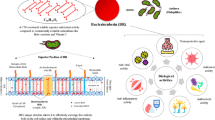Abstract
Two metabolites were obtained by microbial transformation of androstendione in the culture of Aspergillus terreus PTCC 5283, a fungus isolated from soil. Their structures were established as testosterone and testololactone on the basis of the spectral data including 1H NMR, 13C NMR, FTIR, MS and physical constants such as melting point and optical rotation. Aspergillus terreusproduced both metabolites after 3 days incubation at 27 °C. The bioconversion reactions observed were 17-carbonyl reduction and biological Baeyer–Villiger oxidation.
Similar content being viewed by others
References
Chahal, D. S., Moo-Young, M. & Dhillon, G. S. 1979 Bioconversion of wheat straw and wheat straw components into single-cell protein. Canadian Journal of Microbiology 25, 793–797.
Chakrabarti, S. K., Matsumura, N. & Ranu, R. S. 2000 Purification and characterization of an extracellular alkaline serine protease from Aspergillus terreus (IJIRA 6. 2). Current Microbiology 40, 239–244.
Charney, W. & Herzog, H. L. 1967 Microbial Transformation of Steroids, a Handbook. pp. 262–681. London: Academic Press.
Chen, Z. G., Fujii, I., Ebizuka, Y. & Sankawa, U. 1992 Emodin Omethyltransferase from Aspergillus terreus. Archives of Microbiology. 158, 29–34.
Domsch, K. H., Gams, W. & Anderson, T. H. 1980 In Compendium of Soil Fungi, eds. Domsch, K. H., Gams, W. & Anderson, T. -H. Vol 1, pp. 76–124. London: Academic Press. ISBN 0–12-220401-8.
Dulaney, E. L., Stapley, E. O. & Hlavac, C. 1955 Hydroxylation of steroids, principally progesterone, by a strain of Aspergillus ochraceus. Mycologia 47, 464–474.
Eman Mostafa, M. 1995 Progesterone transformation as a diagnostic feature in the classification of the Aspergillus niger group. Lettersin Applied Microbiology 20, 243–246.
Eman Mostafa, M. & Zohri, A. A. 2000 Progesterone side-chain degradation by some species of Aspergillus flavus group. Folia Microbiolica 45, 243–247.
Faramarzi, M. A., Tabatabaie Yazdi, M., Shafiee, A. & Zarrini, G. 2002 Microbial transformation of hydrocortisone by Acremonium strictum PTCC 5282. Steroids 67, 869–872.
Fujii, I., Ebizuka, Y. & Sankawa, U. 1988 A novel anthraquinone ring cleavage enzyme from Aspergillus terreus. Journal of Biochemistry (Tokyo) 103, 878–883.
Hajjaj, H., Niederberger, P. & Duboc, P. 2001 Lovastatin biosynthesis by Aspergillus terreus in a chemically defined medium. Applied and Environmental Microbiology 67, 2596–2602.
Hrmova, M., Petrakova, E. & Biely, P. 1991 Induction of celluloseand xylan-degrading enzyme systems in Aspergillus terreus by homo-and heterodisaccharides composed of glucose and xylose. Journal of General Microbiology 7, 541–547.
Khallil, A. M. & Eman Mostafa, M. 1996 Microbial transformation of progesterone by some zoosporic fungi. Journal of Basic Microbiology 36, 225–229.
Kimura, M., Sekido, S., Isogai, Y. & Yamaguchi, I. 2000 Expression, purification, and characterization of blasticidin S deaminase (BSD) from Aspergillus terreus: the role of catalytic zinc in enzyme structure. Journal of Biochemistry (Tokyo) 127, 955–963.
Kirk, D. N., Toms, H. C., Douglas, C. & White, K. A. 1990 A survey of the high-field 1H NMR spectra of the steroid hormones, their hydroxylated derivatives, and related compounds. Journal of the Chemical Society Perkin Transactions II 9, 1567–1594.
Lacroix, I., Biton, J. & Azerad, R. 1999 Microbial models of drug metabolism: microbial transformations of trimegestone® (RU27987), a 3-keto-Δ4,9(10)-19-norsteroid drug. Bioorganic and Medicinal Chemistry 7, 2329–2341.
Ling, K. H., Liou, H. H., Yang, C. M. & Yang, C. K. 1984 Isolation, chemical structure, acute toxicity, and some physicochemical properties of territrem C from Aspergillus terreus. Applied and Environmental Microbiology 47, 98–100.
Mahato, S. B. & Banerjee, S. 1997 Steroid biotransformations by microorganisms – II. Phytochemistry 24, 1403–1421.
Mahato, S. B., Banerjee, S. & Podder, S. 1989 Steroid biotransformations by microorganisms – III. Phytochemistry 28, 7–40.
Schimmel, T. G., Coffman, A. D. & Parsons, S. J. 1998 Effect of butyrolactone I on the producing fungus, Aspergillus terreus. Applied and Environmental Microbiology 64, 3707–3712.
Wyss, M., Brugger, R., Kronenberger, A., Remy, R., Fimbel, R., Oesterhelt, G., Lehmann, M. & Van Loon, A. P. 1999 Biochemical characterization of fungal phytases (myo-inositol hexakisphosphate phosphohydrolases): catalytic properties. Applied and Environmental Microbiology 65, 367–373.
Yadav, R. P., Saxena, R. K., Gupta, R. & Davidson, W. S. 1998 Purification and characterization of a regiospecific lipase from Aspergillus terreus. Biotechnology and Applied Biochemistry 28, 243–249.
Author information
Authors and Affiliations
Rights and permissions
About this article
Cite this article
Faramarzi, M.A., Yazdi, M.T., Amini, M. et al. Microbial production of testosterone and testololactone in the culture of Aspergillus terreus . World Journal of Microbiology and Biotechnology 20, 657–660 (2004). https://doi.org/10.1007/s11274-004-1003-4
Issue Date:
DOI: https://doi.org/10.1007/s11274-004-1003-4




